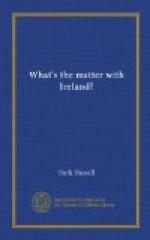“What do you want to know for?” asked the gombeen man, when at the end of Paddy’s back-breaking six months, Paddy and his father brought him the fifteen dollars and asked how much they still owed. The gombeen man refuses accounts to everyone but the priest, magistrate, doctor and teacher. “What do you want to know how much you owe for? Unless you want to pay me all off?”
When Paddy was seventeen he made a still bigger fight against debt. With the sons of other “tied” men, he went to work in the Scottish harvests. His family was not as badly off as those of some of the boys. Some had run so far behind that the gombeen man had served writs on them, obtained judgment against their holdings, and could evict them at pleasure.
When Paddy married and settled down in Dungloe he found the reason for the unpayableness of the debt. One day he and his father shopped at the gombeen store together. They bought the same amount of meal. The father paid cash—seventeen shillings. Forty-four days later, Paddy brought his money. But the gombeen man presented him with a bill for twenty-one shillings and three pence. It did no good to say how much the father had paid for the same amount of meal. The gombeen man insisted that Paddy’s father had given eighteen shillings, and Paddy was being charged just three shillings and three pence interest. Or only 144 per cent per annum!
“Why do we buy from him? Why don’t we get together and do our own buying?” asked the insurgent Paddy. After much reflection he had decided on the tactics of his campaign against poverty and the recruiting for his army commenced that night as the neighbors visited about his turf fire. There was doubt on the faces of those tied to the gombeen man. But Paddy continued: “Let’s try it out in a small way, say with fertilizer. That stuff he’s selling us isn’t as good as kelp, and he won’t tell us what it’s made of.”
The recruits fell in. They scraped up enough money to buy a twenty-ton load of rich manure from a neighboring co-operative society. The little deal saved them $200 and brought them heavy crops. They organized. They needed a store. Up in a rocky boreen on his little farm, Paddy had an empty shed. Again the neighbors explored the toes of their money stockings, and found enough to pay for filling the shed with flour, tea, sugar and meal. Then, if they were “free” men, they came boldly to shop on the nights the store was open—moonlight or no moonlight. But if they were “tied” men, they crept fearsomely tip the rocks on dark nights only. The recruits recruited. Financial and social returns began to come in. At the end of the first year there was a clear profit of over $500. In three years the society was recognized as one of the most efficient in Ireland and presented by the Pembroke fund with a fine stucco hall. Jigs. Dances. Lectures.
But the gombeen man wasn’t “taking it lying down.” He called on his political and religious friends to aid. First on the magistrate. When Paddy became the political rival of the gombeen man for the county council, there was a joint debate. Paddy used reduced prices as his argument. Questions were hurled at him by the reddening trader.




